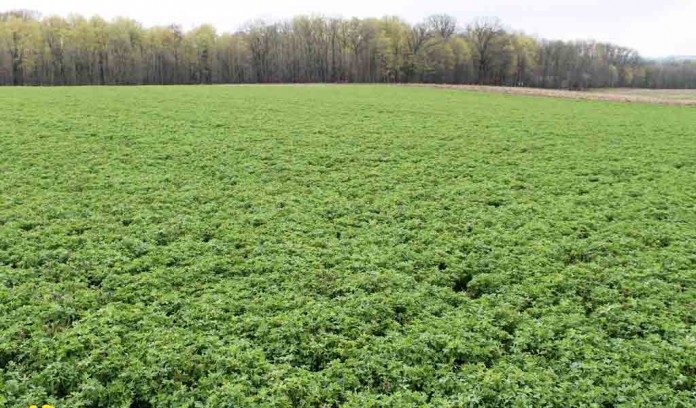Due to excessive rainfall in 2015, many alfalfa stands went downhill and were destroyed or will be destroyed this spring. Now, new seedings need to be established. Have you thought about what needs to be done to successfully establish alfalfa?
Soil samples
The first task is to obtain a soil sample or samples. If the field is less than 15 acres, then a single soil sample will suffice. If the field is larger than 15 acres, take multiple samples based upon management zones or based upon a grid pattern.
Management zones can be based upon soil type, topography, soil organic matter, or a combination of these. If a field has been in no-till and the field will remain untilled, obtain two soil samples per field, zone, or grid: one at a 4-inch depth for pH and another at an 8-inch depth for fertilizer recommendations.
Soil pH
For good establishment of alfalfa, soil pH needs to be 6.8 for mineral soils having subsoil pH less than 6.0, and 6.5 for mineral soils having subsoil pH greater than 6.0.
Bray P1 soil test phosphorus (P) levels should be between 25 and 50 parts per million (ppm). The Mehlich III soil test P levels should be between 40 and 79 ppm. The recommended rate of potash is based upon the soil test level in ppm, the cation exchange capacity, and yield goal.
If lime is required and the Bray P1 soil test value for phosphorus is below 25 ppm, delay planting until the fall or next spring as stand establishment will likely be poor. Fertilizer and lime should be incorporated to maximize efficiency. If surface applying lime and fertilizer, it is even more important to wait a year before establishing alfalfa.
Seed preparation
Select varieties having the best disease resistance (the best way to fight diseases), good forage quality, best fit to soil types, and high yields. Have seed inoculated with nitrogen-fixing bacteria and treated with fungicides to manage seedling diseases, especially when planting in the spring.
Prepare a proper seedbed
A smooth firm seedbed allows for good soil to seed contact leading to improved establishment.
Control all weeds prior to establishment. Control perennial weeds the year before establishment. For no-tillage seedings, control grass sod with glyphosate at least one month in advance of seeding and manage previous crop residue for good soil to seed contact.
Seed alfalfa as early in spring as possible. For southern Ohio target March 15 and for northern Ohio target April 1. For fall seedings, plant as close to August 1 as possible. Seed alfalfa to a depth of _ to _ inch in clay and loam soils and _ to _ inch in sandy soils.
Weed control
Control weeds for best establishment of alfalfa. Alfalfa yields may be improved at least 8 percent over the life of an alfalfa stand if weeds are controlled in seedling alfalfa. To control the most weed species in non-Roundup Ready alfalfa, apply Raptor at 4-6 fluid ounces per acre to 1-3-inch weeds.
Raptor controls lambsquarters, annual grasses and ragweed more effectively than Pursuit. Include ammonium sulfate or urea ammonium nitrate along with a methylated seed oil at 1-1.5 pints per acre.
In Roundup Ready alfalfa, apply glyphosate at 0.75 pounds acid equivalent per acre (22 fluid ounces of a Roundup product) to three-four leaf alfalfa. Include ammonium sulfate at 8.5 pounds per 100 gallons of spray mixture.
It is critical to properly manage leafhoppers in seedling alfalfa. Successful establishment ensures the healthiest, longest lasting, and highest yielding alfalfa.













